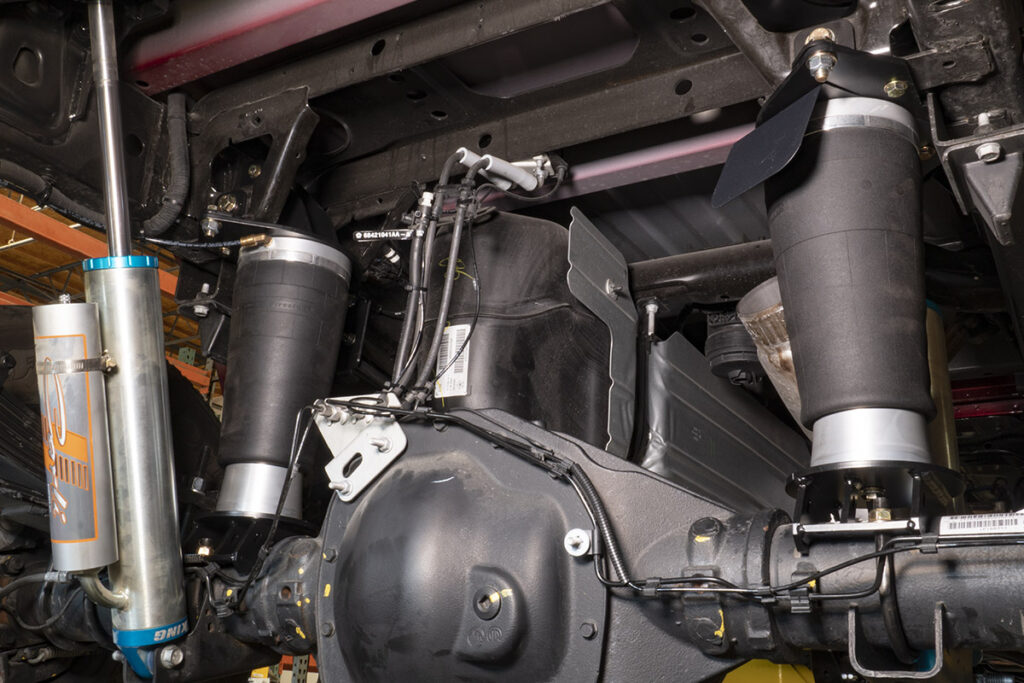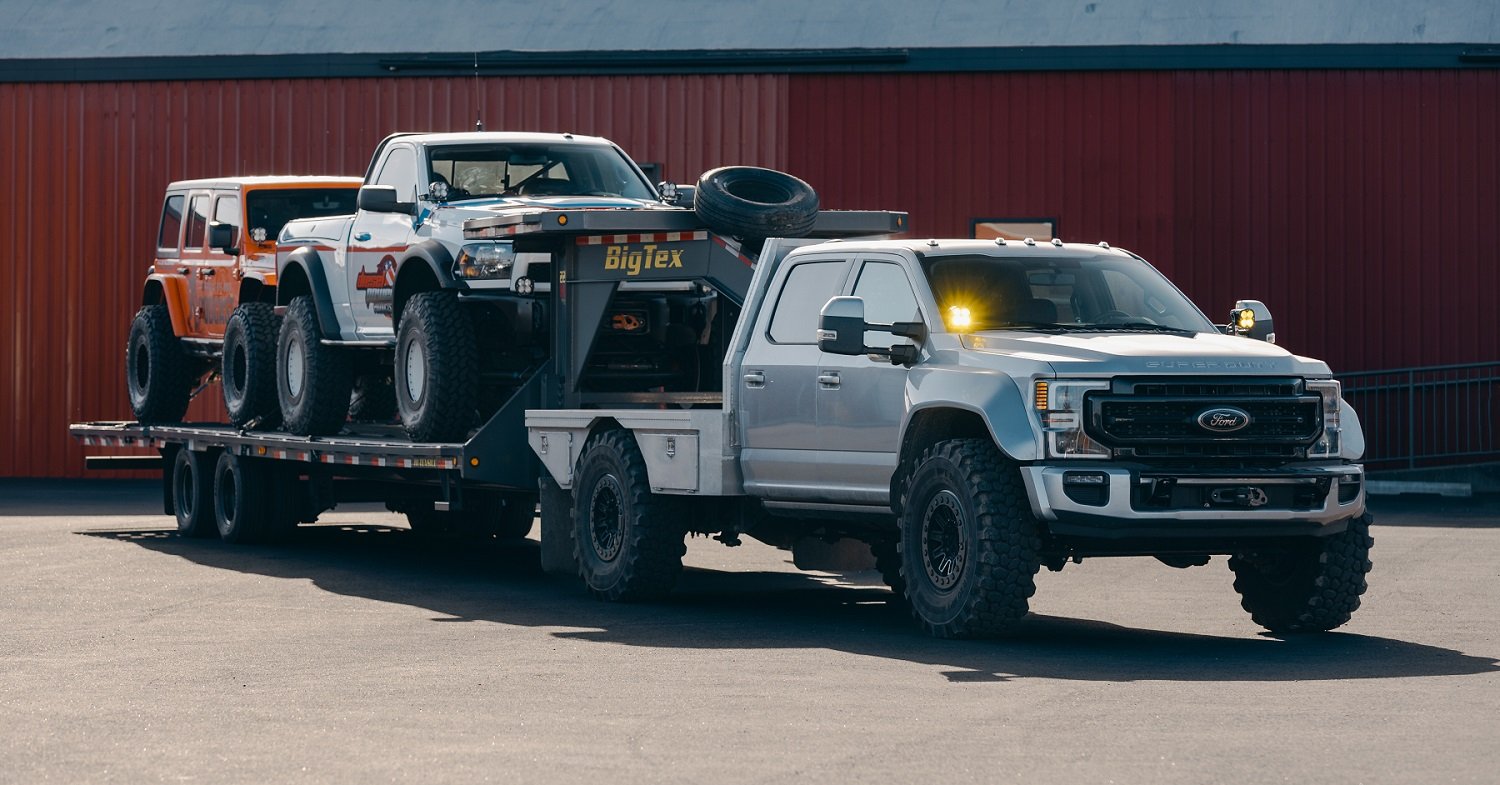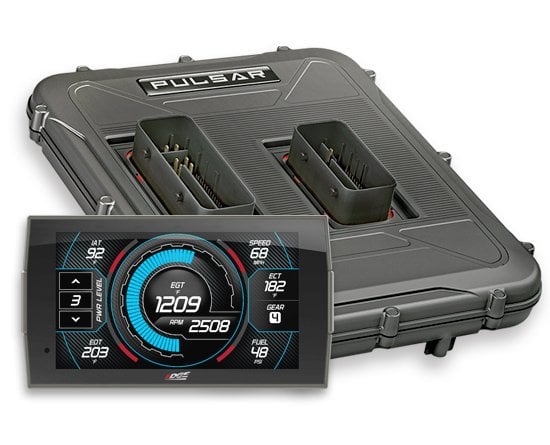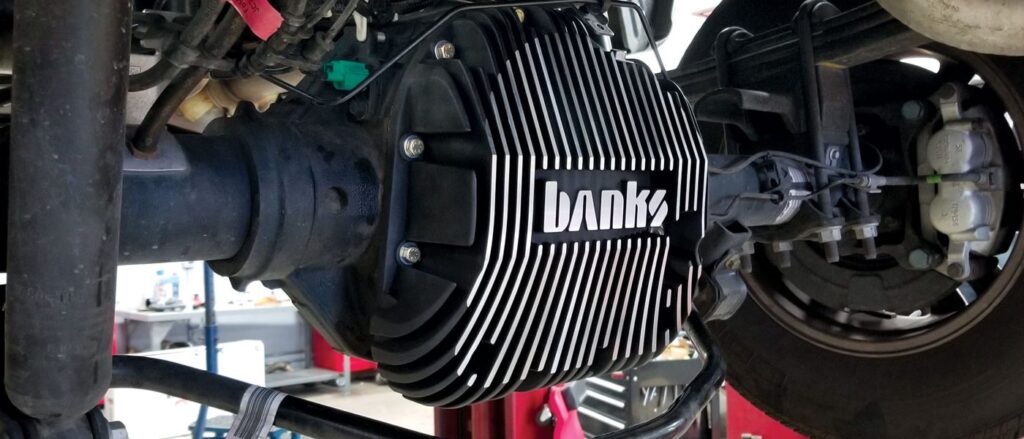Part of the reason you own a diesel pickup is because it’s able to tow and haul a lot more weight than any other passenger vehicle on the road. While the best equipped ½ ton or 1500 series trucks may be able to pull a trailer that weights around 10,500 pounds, its bigger diesel-powered brother will be able to triple that figure when properly equipped. Simply put, the torque of a modern diesel combined with the heavy duty chassis of a 2500 or 3500 series truck means it can pull literal tons of weight, but just like in every aspect of vehicle design, the factory builds for the masses rather than the outliers, so if you use your truck to tow daily or close to the maximum weight rating, you may notice a few shortcomings like sagging suspension, inadequate braking performance, a swaying trailer, fluid temps getting a little warmer than you’d like, or even a lack of power.
The aftermarket has come up with solutions for just about every shortcoming you may find when hauling or towing, so with a few simple modifications, you can transform how your diesel hauls a trailer. It is worth noting however, that you should never haul more than your truck is rated to carry, and no towing modification will change your max GVWR, but will make your truck better able to handle the weight, run cooler, and perform better when loaded.
Handling The Weight
You’ve probably noticed how the rear end of a heavy-duty truck sits a bit higher compared to the front, and while most people fix this look with a leveling kit, part of the reason why the factory makes the trucks have a slight rake is so when the rear of your truck is loaded down with cargo or a trailer, it will be level with the front. Since more weight will naturally compress your springs further, if you have a leveled front suspension or you’re carrying a lot of weight, the rear end may sag below the level of the front which not only looks horrible but can cause your headlights to blind oncoming drivers along with a harsh ride.
In the olden days, if you wanted to prevent this sagging and squatting from happening, you would install extra leaf springs in the rear to help push back against the added weight, but the problem is this creates an extra stiff ride when the truck is empty. This is fine for a dump truck, but for a daily driven diesel there are better choices. The first is the Timbren Suspension Enhancement System, or SES for short. Timbrens are a specially designed bump stop that are slightly longer than your stock ones but are made from a much more durable and stiffer material that resists compression. When you are driving along unloaded, there is still enough space for the axle to travel without contacting the Timbren SES, but when you add weight into the rear of the truck, it will be pushed down just enough to contact the SES, which will then hold up the extra weight and stop the squat. The best part about the Timbren SES is it’s a passive system that easily installs in a few minutes with basic hand tools, is a very affordable option, and it requires no electronics to operate.

Another option which is a favorite among diesel drivers is an airbag system. No, not the kind that keeps you safe during a crash, but instead an auxiliary air spring that’s added to your suspension to help hold up the rear of your truck when you need it. Kits are available from Pacbrake, Carli, and several other manufacturers for all common HD pickup trucks, and once installed, they will be able to hold the rear of your truck level, even while running at maximum GVWR. The best part is, because the air spring can be inflated or deflated on demand, your ride quality will remain unchanged while driving empty, plus the Carli air bags work with long travel suspension. You can choose to manually inflate the air spring at nearly any gas station or at home if you have an air compressor, or you could also choose to install an optional on-board air compressor system which lets you inflate or deflate the airbags with the touch of a button from inside the truck, and you also will have a pressure gauge which lets you keep an eye on things.
Holding up the weight of your cargo in a static environment is one thing, but there are certain loads that need a little more work to manage during transit. A slide-in camper is a popular way to turn your hauler into a home away from home, and because of its weight, you will probably want to have an airbag or other form of helper spring to handle the weight, but that’s not the only consideration you need to make. As you drive down the twists and turns of back roads, the high center of gravity of the camper can wreak havoc on your trucks normal handling. Slight bends in the road you wouldn’t normally notice will now cause the truck to lean side to side forcing you to slow way down.
A rear sway bar kit from Hellwig is a great way to counteract the extra lean from a top-heavy load, and it will work great by itself or in addition to your airbag kit or Timbren SES. It will help the trucks suspension stay flatter during corners, improve handling, and give you more confidence while driving on twisty roads while loaded or empty.
Stopping the Momentum
The single most important thing about hauling a trailer is being able to safely bring your load to a stop. Whether you’re going down a mountain pass or quickly slowing down when another car pulls out in front of you, it’s extremely important to be able to stop in a hurry. Most trucks built in the last 20 years have four-wheel disc brakes with multi-piston calipers on all four corners which by themselves provide amazing stopping power, and some trucks come equipped with a trailer brake controller which can actuate the electric brakes found on most trailers. One more feature that’s been popular with OEM’s over the last 10-or-so years is an exhaust brake which uses backpressure inside the engine to slow down your vehicle with extremely effective results. While the factory equipment on a brand-new truck will stop most loads, if you have a couple year old rig, you may not have some of the trailering equipment that the newer trucks have, but you can always add those features after the fact.
For me, the first add-on that I want to install for towing is a trailer brake controller, and some trucks not originally equipped can still be outfitted with a factory style brake controller for an OE look. If you have a 2011 to 2016 Powerstroke you can pick up a Dorman controller or for a 2013-2014 Ram you can pick up an OEM Mopar switch, both of which will install in their respective factory location on your dashboard. You will have to get your truck programmed at the dealership and confirm the correct wiring harnesses are present in your truck, but this will be the most seamless way to control trailer brakes.

If your truck is a bit older or not equipped with the right wiring harness, you can still have properly working trailer brakes. An aftermarket solution like the Tekonsha Prodigy ID is a great choice that will integrate into your truck, and with its sleek two-piece design, you don’t have to stare at an ugly control box bolted to the dash like you normally do with aftermarket brake controllers. All you see is the knob with built-in display, and the dash module and power module are all hidden behind the dashboard along with the wiring.
After a trailer brake controller, the next most effective braking upgrade you can is an exhaust brake. Some older trucks like the LBZ or LMM Duramax are equipped with a variable geometry turbo but not a factory exhaust brake, but a towing tune can be added where the turbo vanes are closed as you let off the throttle, which will prevent air from escaping through the exhaust like it normally does. This forces the pistons to compress air rather than push it out of the exhaust, which absorbs energy and slows the truck down. With custom tuning from PPEI or Duramax Tuner you can take advantage of the VGT your truck already has and unlock the impressive turbine braking capability the factory ignored with early VGT trucks. This will allow your truck to maintain speed downhill and decelerate with much less stress on your service brakes, which means your pads and rotors on the truck as well as the trailer brakes will run cooler and last longer.
If you have a truck without a VGT like a 2007 or earlier Ram, you can still improve your stopping power with a Pacbrake In-Line Exhaust Brake Kit or a BD Power Turbo Mount Exhaust Brake. Since there are no vanes to close in a fixed geometry turbocharger, the kit includes a butterfly valve which mounts in the exhaust, which is actuated by an air cylinder. When braking power is needed, the valve closes, and exhaust gas is not allowed to escape so it gets compressed by the pistons which absorbs energy and slows the truck down. The controller will also ensure the torque converter stays locked while the butterfly is closed to further improve the braking power being transferred through the transmission.
Starting the Momentum
Once you have the ability to safely maneuver and stop your loaded trailer, the next area you may want to address is power. Whether its maintaining speed while climbing up a steep grade or simply being able to pull out into traffic and get up to speed quicker, a little extra torque can come in handy. The first place people turn to for a little more power is a programmer or tuner, and this could be in the form of a custom tune as mentioned before or even a programmer from Edge like the Pulsar, Evolution, or EvoHT2. Changing things like boost pressure, injection timing, and fuel quantity can improve horsepower and torque which helps your truck get moving a little quicker, and options for heavy towing or light towing tunes mean you’re covered in every scenario. One quick side not worth making here is Edge recently developed the ability to unlock the 2017+ L5P Duramax ECM via the OBD2 port using their EvoHT2 programmer and Locksmith module, which was thought to be impossible just a few years ago. Now, your L5P can easily benefit from a towing or sport tune replacing your stock ECM.
Aside from programming, one more extremely effective upgrade you can make for towing power is changing the gear ratio in your differentials. Gears multiply torque, and the higher the number of your gear ratio (4.10, 4.30, 4.56), the more effective torque you will have at the tire, but the tradeoff is a higher RPM while cruising at highway speed. Most diesel trucks come with a 3.42 or 3.73 ratio and a select few come equipped with a 4.10, but if your truck has a larger than stock tire size, you may want to consider re-gearing to help offset some of the leverage you’ve lost from the larger diameter tire. The ratio you choose will depend on what size tire you’ve installed and personal preference, but generally a 4.30 or 4.56:1 ratio can help offset a 35- or 37-inch-tall tire and give your engine more leverage to help move a heavy trailer.
One thing to consider before you tackle the job, is re-gearing an axle is not for the faint of heart and is usually best left to the professionals. The ring and pinion gears must be put into the exact spot within a thousandth of an inch to establish the proper contact pattern and bearing preload also much be set properly to ensure a long and happy life of your new gears. In addition, if you have a four-wheel drive truck, both the front and rear axles must be re-geared with the same ratio which means twice as much work, but once it’s done, you can have both the taller off-road tires you want and the towing power you need.
Temperatures Under Control
While the list of mechanical upgrades that would help your truck produce more power and tow up a mountain faster goes on and on, the one thing you need to consider before adding tons of power is heat management. Towing does produce a ton of heat in every part of the drivetrain, and if you can’t reject enough heat, you will have problems. The amount of heat your engine produces is directly related to the temperature of combustion, so if you can keep your EGT (Exhaust Gas Temperature) a bit cooler, your engine oil temp and coolant temp will both follow suit. Small changes like a cold air intake or filter back exhaust can lower EGT by reducing airflow restriction into and out of the engine, and a more efficient intercooler like the Banks Technicooler or a Mishimoto Performance Intercooler can remove more heat from the charge air before it enters the engine which will improve power and increase fuel efficiency as well.
Transmission temps are also important to keep an eye on, and if yours are getting much over 170 to 180 for an extended length of time, you may want to look into a larger transmission cooler. Upgrades are available for just about every diesel pickup from BD Diesel, Mishimoto, and PPE that will bolt directly into your truck and drastically reduce your trans fluid temps. There’s an old-school rule of thumb that states for every 20-degree increase in transmission fluid temperature over 175°F your fluid life is cut in half, so you can see how important it is to keep a cool transmission.
The last part of the drivetrain most folks ignore is the rear differential. While towing, the gear oil can see temperatures over 300°F which will cut its life exponentially and increase wear on differential components. Aside from style points, temperature control is a major reason why you should install a Banks Ram Air Differential Cover. It will force air over the cooling fins on the back of the diff cover which drops fluid temperature significantly.
Improving What the Factory Built
Whether your diesel truck is brand new or 15 years old, there is always room for improvement in how it performs. You can upgrade your tow rigs stopping power, cooling ability, or horsepower production, and these slight changes and modifications can drastically improve your trucks performance and longevity, and safety, which is arguably the most important aspect of them all.



